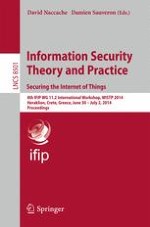2014 | Buch
Information Security Theory and Practice. Securing the Internet of Things
8th IFIP WG 11.2 International Workshop, WISTP 2014, Heraklion, Crete, Greece, June 30 – July 2, 2014. Proceedings
herausgegeben von: David Naccache, Damien Sauveron
Verlag: Springer Berlin Heidelberg
Buchreihe : Lecture Notes in Computer Science
